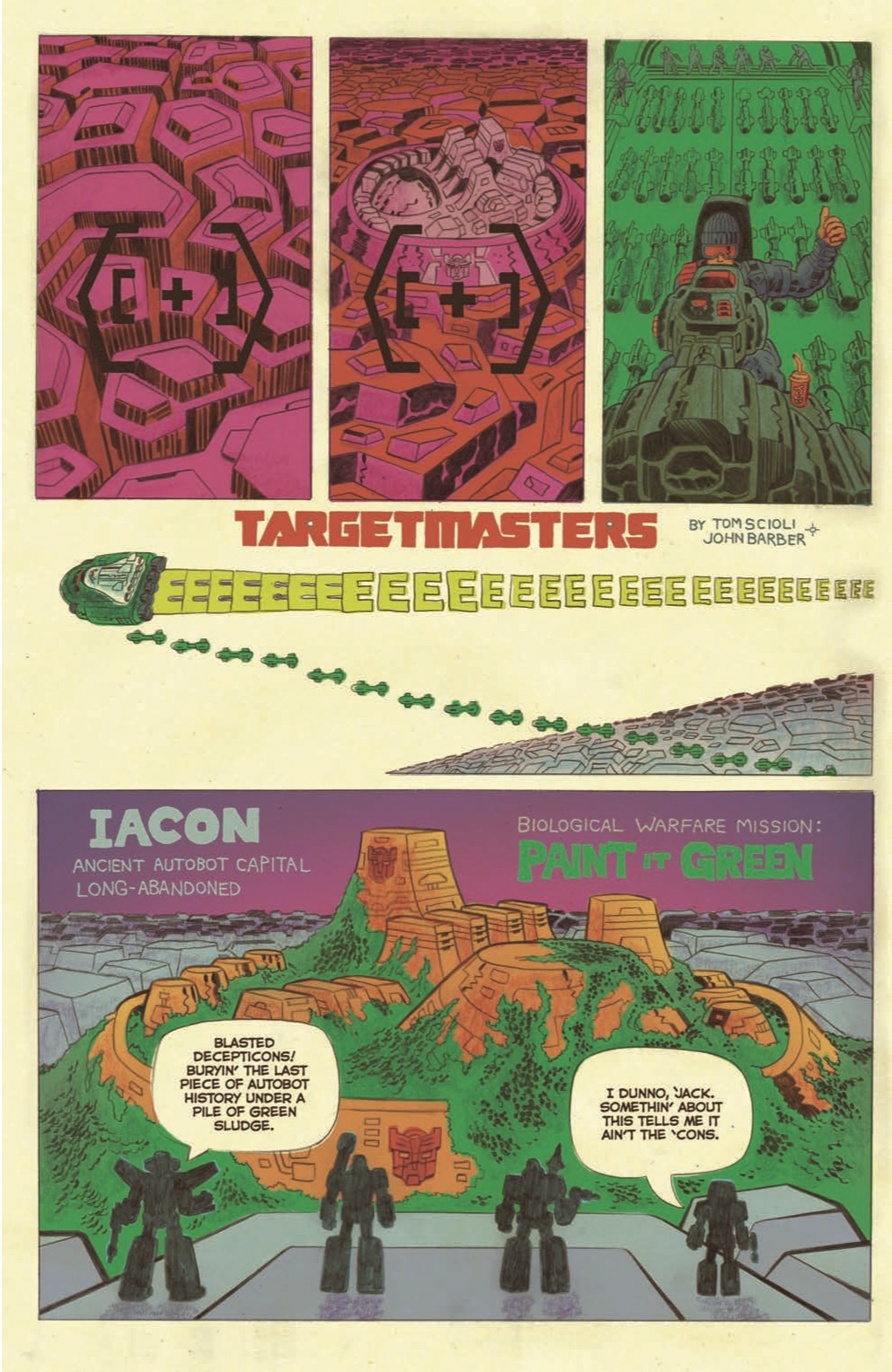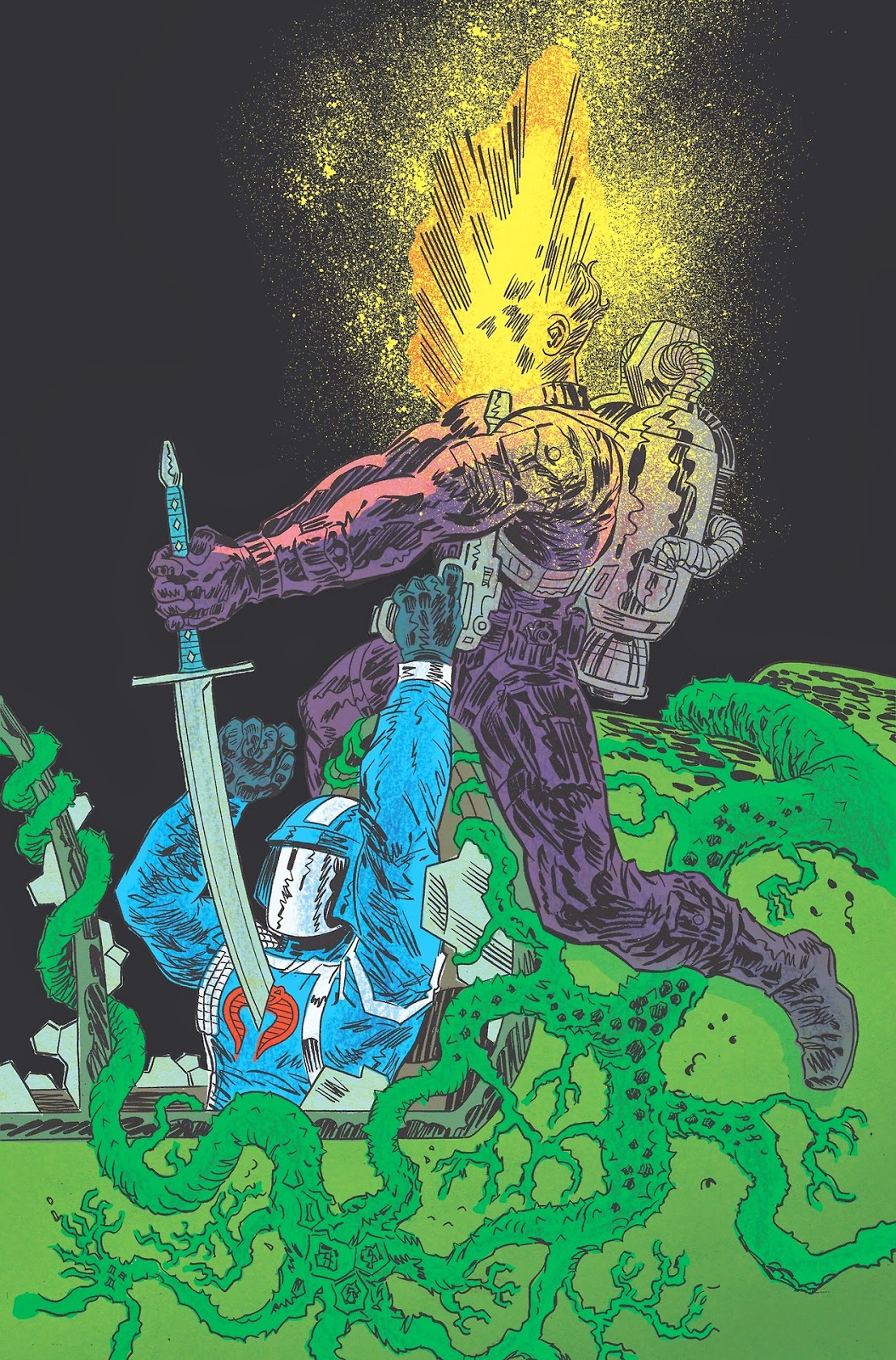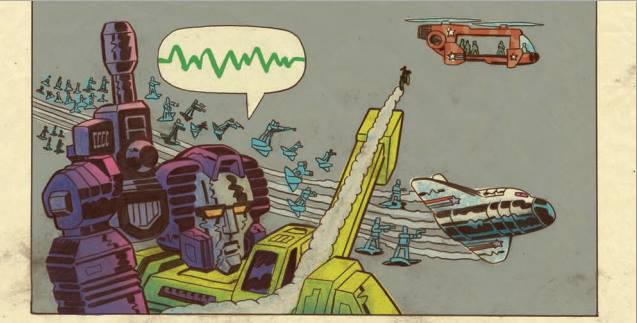At last weekend’s Small Press Expo, Deadshirt comics editor Max Robinson sat down with writer-artist Tom Scioli (AdHouse Books’ American Barbarian, Image’s Gødland) to discuss his latest project, Transformers vs. G.I. Joe from IDW.
MR: Before you got started on the book, I would see you tweet about all the research you were doing. How did you go about approaching all that, wrapping your head around these action figure characters?
TS: I just sorta followed my nose. I just got as much of this stuff as I could find and whatever jumped out to me, whatever appealed to me–sometimes just whatever was closest–I’d just sorta start there. I knew I wanted to read the comics since I was doing a comic, I wanted to get the thing closest to what I wanted to do. And I’d heard that the original G.I. Joe series…
MR: The Hama stuff?
TS: Yeah, so I made sure to check that stuff out and watch the old cartoons. But yeah it was basically just getting my hands on as much material as possible and immersing myself in it, and also I was sorta checking out things that might be connected to it somewhat, like videos of actual robot research. Like, how a robot exists in reality? And also what informed these series, like old war movies. So much of G.I. Joe, like the iconography, is based in World War II specifically, and the Hama stuff was very much rooted in Vietnam.
MR: It’s also this weirdo alt-universe take on S.H.I.E.L.D. and HYDRA since it started out as an old Marvel pitch.
TS: I didn’t study that stuff too closely since I already know it so well to begin with, but the parallels were definitely there and I did think about Steranko specifically in terms of presentation, like the mechanics of the comic itself.
MR: You can definitely see a lot of that in the layouts in the three issues I’ve read. So when you’re working with licensed characters like this, do you have specific storytelling goals? Like, what you want this story to be at the end of the day?
TS: I try to put aside the fact that it’s a licensed book and convince myself with self-hypnosis that these are characters and drawings I came up with in my sketch book and that I’m about to make a comic about them. It gives me the freedom to make this thing into a good comic. If I looked at this as “this is a license, I need to be true to the license, I need to hit the notes the fan base wants,” it’d just be too overwhelming. I can’t see how you could make a comic that way.
MR: What appeals to you about these characters, and why do you think they’ve outlasted the ’80s the way they have?
TS: There was a lot of money spent initially to get those things on TV. So there’s that: Somebody in 1980-whatever spent a ton of money and a ton of advertising and made a ton of toys and that stuff leaves ripples. So there’s the cycle of nostalgia every twenty years. But then also there’s the things themselves. What is it about this thing? With G.I. Joe, the reason why people keep coming back to it is the quality of what Hama put down, this personal, exceptional work that people want to revisit and celebrate and learn about. Army toys, army stories have always had this eternal, elemental appeal. We want to imagine what it’s like to be a warrior or a hunter. Specifically with G.I. Joe, since it came out of Vietnam, they were trying to think of ways to make a war toy and a war story for kids that’s less specific. More adventurous and imaginative, more fantasy.
Transformers are these giant robots that turn into trucks, so of course little boys and girls are going to fall in love with that, there’s incredible appeal. And then you add to that the robots that turn into robot dinosaurs!
MR: It feels like Hasbro and IDW have been pretty hands off with this project.
TS: They were pretty hands off in the beginning but in this most recent issue there were a number of things I was told I needed to change. So I had to change them, and in some of the cases I took that as an opportunity to make something better. In some of the cases I wasn’t able to come up with a solution and I had to go with an inferior element; I had to take something that I thought worked and take it a step down.
But that’s very, very recent, and I attribute that to, when this thing happened, it was just sort of a lark. Like “oh, let’s put out a Transformers/G.I. Joe comic and see what happens.” Now it’s a hit and it’s like “okay, we have something here,” so there’s more eyes and more attention on it. So it should be fine, I just wasn’t anticipating that change, so now with the next issue I’ll create with that in mind and lean towards things I’m interested in and want to do but that wouldn’t trigger a reaction like that.
MR: What sort of interested me about this project, aside from being a fan of your work for a while, this is the first Transformers book I’d seen from IDW that wasn’t part of a much larger existing story or a tie-in to the action figures. It was like “Woah where did this come from?!”
TS: I feel incredibly fortunate for that, too. Transformers vs. G.I. Joe seems like one of those things that you could do a bunch of like concurrent series and spinoffs, and because they chose not to do that and just have this one book I’m able to create to my fullest capacity. That’s the thing that made me not want to do mainstream comics, to not do superhero comics for Marvel or DC. I don’t know how you can create something real while at the same time trying to make sure I don’t contradict something going on over here. It doesn’t work for me as a reader and it would be intolerable for me as a creator.
So with this, I feel so fortunate because I don’t have to worry about contradicting someone’s idea of, like, who Snake-Eyes’ uncle is. I don’t need to worry about that, I just need to worry about making a cool comic.
MR: Yeah, that was nice to me because even though I’m familiar with these properties, that Free Comic Book Day #0 issue is great because it’s like “Here’s Snake-Eyes’ whole deal, he got shot in the face by Cobra Commander, boom, that’s where he goes from here.”
MR: So, on Twitter you described Transformers vs. G.I. Joe as your ‘oversized licensed mini-comic,” and that definitely comes through in the way this feels like one of those little comics you’d find packed in with a He-Man action figure, or those late era Kirby Superpowers comics. Was that a deliberate choice or did that just sort of happen?
TS: You know what’s funny? Those comics are just so much a part of my DNA because they’re some of the first comics I ever read, so that’s definitely in there. But what I like about the word “mini-comic” is it actually means two very opposite things, especially at a place like SPX. When someone talks about a mini-comic, they’re talking about one of those little things that comes with He-Man, but it also means this alternative art comic that you created and xeroxed and sold at a show. And to me, this is both of those things.
MR: I think I described the comic to someone yesterday as the equivalent of DC hiring Michel Fiffe to do COPRA as an actual Suicide Squad comic.
TS: And I feel like that’s inevitable, you see that all the time. This is a bad example, but that movie Rockstar with Wahlberg, where it’s like a cover singer guy that’s so perfect he gets hired to be in the real thing. Or Liam Neeson being in that Star Wars knockoff Krull and then you flashforward twenty years later and he’s the star of actual Star Wars.
MR: The thing I’ve really been enjoying about Transformers vs. G.I. Joe is you have this incredible sense of scale for everything. Like, especially that one panel in issue three where Scarlett rides a motorcycle off of Devastator’s shoulder when the Joes are like Shock and Awe-ing Cybertron. Obviously you put a great deal of thought into that.
TS: I did, and you know I thought to myself “Okay, what are the problem areas here? What are the things that are going to be really difficult on this series?” and that was a big one. Scale was a really big concern because the Transformers are huge and the humans are small, so how do you make interesting compositions that involve both of them? And then you had to keep the scale straight.
MR: Which even the cartoons and stuff couldn’t do! You had Megatron turning from this giant robot into a gun that a human could hold.
TS: And that’s what I embraced about it, I tried to make the scale consistent, but I embraced that this scale is just going to be fucked up.
MR: So there’s obviously a great deal of Kirby influence in your work and, with this book, Steranko is very much there. How do you temper those influences so they don’t overwhelm your work?
TS: That sort of thing is just intuitive. I just draw the way I draw and my influences are all in there, and they come out when they’re going to come out just by virtue of the fact that I’m letting it flow. I didn’t always work that way. I’ve done works in the past where I had like an end goal for the aesthetic and I’d cultivate my art in that direction, but I don’t do that anymore. I let things just end up the way they end up.
MR: At the end of each issue, you and [Senior Editor for IDW’s Transformers and G.I. Joe titles and Transformers vs. G.I. Joe co-writer] John Barber have been doing these little running text commentaries. How did you guys decide to include that? So many comics writers I know are really not interested in talking about their process like that.
TS: There’s a couple reasons. The first reason was when we were putting that Free Comic Book Day issue together, we had to figure out how to make this thing bang for their buck even though they weren’t actually spending a buck. We had all this space that would otherwise just be ads, so I came up with little extras.
The other reason, and this is an issue I’ve noticed a lot of artists have had with their work, is…people who know you or who talk to you at a show have an appreciation for your work, but someone picking up your comic with no prompting, they have a minute or two to figure out if they like it or hate it. And that sort of frustrated me a bit: am I going to have to go door to door explaining this thing for them to like it? So this was a way to do that. You can either stop when the story ends or read about why I did what I did.
MR: I don’t think I’d enjoy it as much if it was just you but having Barber there is cool, because I get this sense he’s like the David Goyer to your Christopher Nolan in terms of knowing all the lore and keeping the ship straight.
TS: He’s been working for this stuff forever and he knows it inside and out. So it made sense to me to collaborate with him because when I started on this project I didn’t. So there’s stuff that’d be glaringly, horrifyingly mistakes to make that I’d be totally ignorant to. That said, from the time that I did this from now, I’ve learned a lot. I’m not on John’s level in terms of, like you said, the lore but I’m getting there.
MR: I’ve really enjoyed the movie reviews you’ve done for Comics Alliance that are these sort of off the cuff, instinctual takes on movies like Man of Steel or the most recent Transformers movie, so the Transformers vs. G.I. Joe commentaries felt very much in that vein.
TS: That tends to be the most honest reaction to something, to belabor it too much there’d be too much artifice. And I do like with these things that sometimes I’ll say something I regret.
MR: So how much of an ongoing series is Transformers vs. G.I. Joe? Do you have an end date in sight?
TS: My thought is that I’m going to treat it like Jack Kirby did Fantastic Four or Ditko did Spider-Man without hopefully reaching that point where things go sour. I could see myself doing this indefinitely. It provides me with creative fulfillment and satisfaction, minus a few of those minor things I’ve mentioned and they may even resolve themselves. I had been wanting to do a massive, sci-fi space opera and the time wasn’t right until this. So this is my massive, multi-millenial sci-fi epic space opera.
MR: Can you tease anything coming up in the next couple of issues?
TS: There’s a spaceship full of the G.I. Joe pets coming to Cybertron along with supplies and things.
MR: [Laughs] So, like Snake-Eyes’ wolf?
TS: We’re still trying to decide if he’ll be a part of it since we’re not really sure what Snake-Eyes’ allegiances are at this point in the story. The Oktober Guard is going to show up and they’re going to be very different from how they’ve been depicted previously. My friend [Hip Hop Family Tree writer-artist] Ed Piskor loved G.I. Joe comics as a kid and when I told him I wanted to do the Oktober Guard he was like “Fuck them, their costumes are silly, they suck. If you can make the Oktober Guard cool then you’ve really accomplished something!” and so I created something very very different and something I’m proud of, and I showed it to him and he was like “Dude, you did the impossible. You made the Oktober Guard cool!”
MR: Are you working on anything else or is this it right now?
TS: This is it. It’s a job where I can do what I want with it, and I make an amount I’m happy with, so I’d rather put every ounce of effort, time and imagination that I have into this one project. Up until I got this project, I wasn’t exclusively making my living from comics, I’d try this and it wouldn’t work, I’d try that and it didn’t work. I’d have multiple things going at once that I couldn’t justify putting all my effort into but this is something I want to pour all my heart into. For me, the big goal you’re shooting for here, sort of the ultimate goal here, is to make one of the great comics of all time. And you’re not going to do that with divided focus.
Transformers vs. G.I. Joe is available monthly from IDW.
Editor’s note: An earlier version of this piece identified John Barber as the former editor of IDW’s G.I. Joe and Transformers titles. This was incorrect, he is the current editor.








One thought on “Tom Scioli and the Scale and Appeal of IDW’s Transformers vs. G.I. Joe [Interview]”
Comments are closed.